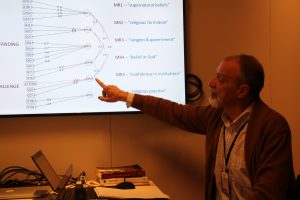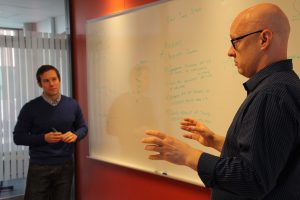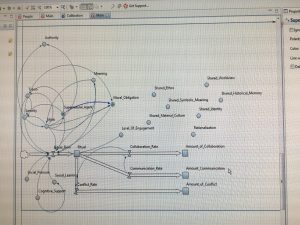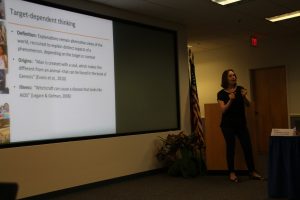When most people think of the study of religion, they think of ancient languages, sacred texts, congregational surveys, or anthropologists setting up camp in a tribal society. What if we could use computer simulations to recreate historical events, learn about religious violence and terrorism, and understand religion’s role in transitions from pre-agricultural to industrial societies?
Computational social scientist Justin Lane thinks computer modeling can help us understand complex social phenomena like religion. Once we unlock this powerful method, he says, “We can no longer be content with rudimentary answers to the hard questions that religion poses.”
PROJECT OVERVIEW
The Modeling Religion Project (MRP) is an ambitious attempt to connect the sciences of modeling and simulation with the scientific study of religion. It has unfolded over the last three years, assembling a group of computer simulation experts and religion scholars to collaborate on computer simulations that reveal insights into how religion affects people and societies.
Together, team members studied the cultural, cognitive and ritual processes that undergird religion and culture. They produced models of terror management and mutually escalating religious violence, and made progress on models exploring social identity, ritual competence and credibility enhancing displays.

This project demanded that religion scholars and computer specialists work far outside their comfort zone and rise above disciplinary constraints in order to understand each other. The religion scholars worked to clearly describe the theories in their field to computer scientists, and they pushed themselves to assemble precise computational expressions of these theories.
This kind of radical interdisciplinarity “forces all involved to spend inordinate amounts of time digging into domain specific literature, reworking and retesting code and explaining concepts and ideas that have always been accepted as fact,” said computer scientist and team member Dr. Ross Gore. “Frequently, a model smaller in scale and more limited than originally intended is produced but it’s amazing how much insight can be gained from such a tiny, limited model.”

Another team member, philosopher and theologian Dr. LeRon Shults, was so inspired by the complexity and clarity harnessed by computer simulation that he joked, “this is the methodology from which I was separated at birth!”
Working together, these experts developed a fruitful balance between the simplicity needed to understand the models and the complexity needed for the models to accurately reflect human behavior and religious processes. The team built virtual computer agents with complex cognitions, capable of testing many theories on beliefs and experiences. What they forged was the first comprehensive effort to systematically model the predictions of many different cognitive and social theories of religion in various simulated settings.
MODELS GENERATED
A brief overview of some of the models produced will illustrate the rich, broad range of this project. One model, MERV, was an agent-based model exploring xenophobic anxiety in an artificial society of two different religious groups where agents experience hazards. The model was developed based on several empirically validated theories about the role of religion in intergroup conflict. The model identifies some of the conditions and mechanisms that engender mutually escalating xenophobic anxiety between religious groups.
Another model, the Shamanism and Possession Model, is an agent-based model that simulates the social and psychological dynamics that influence whether men or women will fulfill a shamanic or trance-healer role in a society. Our results showed that in different types of societies—depending on how hierarchical the society is—women and men are differently afflicted by psychosocial trauma, which leads to gender variations in who is more susceptible to the dissociative trances of the shaman healer.
In the model we call Forest, we ask, why aren’t there more atheists? In this systems dynamics model we identify the conditions under which a population with widespread supernatural beliefs can change into one in which most individuals reject supernatural explanations.

While the conditions for producing widespread rejection of supernatural worldviews are highly specific, historically rare and difficult to produce, when those conditions combine, there emerges a stable social equilibrium that makes atheism widespread. However, this equilibrium is easier to disrupt than those whose cohesion is stabilized by supernatural religion.
GOALS ACHIEVED
One major goal of the MRP was to produce a web-based simulation platform that will allow scholars and students to create complex simulations with no knowledge of programming. Currently, the simulation platform can be used to test a range of questions about social behaviors, and it is still being refined to accommodate more specific questions about religion.
When it is complete, it will allow modelers to specify the cognitive, emotional, and social characteristics of agents; the causal architecture governing how those characteristics interact; the processes by which agents learn from one another; and the types of groups that agents can form…all without any coding. This product is part of our strategy to stabilize and grow the use of these methods within different disciplines.
The Modeling Religion Project, as a research methodology, pushed the study of religion into the computational and scientific space in a way that’s never been done before. There have been a few agent-based simulations of social and cognitive processes involving religion; they use relatively simple agents that clarify causal architecture but make the capturing of any complex cognitive cultural phenomena, including religion, extremely difficult. This project has created a new standard for theoretical consistency and empirical accountability in the study of religion, enhancing understanding of human life and its complex, adaptive systems.
Beyond research innovations, the MRP team members will continue to press forward in developing social simulation technologies for addressing humanitarian and societal challenges. The next step is to effectively share these simulations with policymakers and opinion leaders, in order to help them make fact-based arguments for robust solutions to pressing social problems such as religiously-rationalized violence, radicalization, mass migrations, and child trafficking.
Dr. Ross Gore noted that computer simulation “enables decision makers to enact policies that are not only more likely to succeed but in many cases simpler to implement. This approach is ruthless because it highlights bad decisions and policies quickly and thoroughly in a way that informed discussion cannot.” The applications of the Modeling Religion Project’s pioneering research are on the horizon.
LIST OF PROJECT OUTPUT
MRP team members produced a series of simulations, sharing results at many conferences, producing a number of articles and an edited volume, a documentary film series, and greatly enlarging the conversation around this cutting-edge adventure in the academic study of religion. The project also helped spearhead a new grant from the Research Council of Norway that led to the Modeling Religion in Norway (MODRN) Project, and soon after, the Center for Modeling Social Systems (CMSS).

Selection of Conference Presentations
2017 meeting of the International Association for the Psychology of Religion in Hamar, Norway. Paper title: “A New Model of Religion, Ritual, and Cybernetic Self-Regulation.” Authors: Wood & Diallo.
2016 meeting of the Complex Systems Society in Amsterdam. Paper title: “Why Hierarchy? Coupled Oscillator Dynamics and the Emergence of Social Complexity.” Authors: Wood & Lane.
2016 meeting of the American Academy of Religion in San Antonio, Texas. Paper title: “Simulating Shamanism: How Modeling and Simulation Can Help to Formalize Theories from Religious Studies.” Authors: Wood & Diallo.
2016 meeting of the International Association for the Cognitive Science of Religion in Vancouver, BC. Paper title: “The Logic of Ritual and Self-Regulation: A System Dynamics Model of Costly Signaling in Religious Groups.” Authors: Wood & Diallo.
For a full list of publications associated with the MRP, click here.
Other Tools for Discussion
Video Narratives
Project Blog
For any inquiries or comments, please email admin@mindandculture.org.
